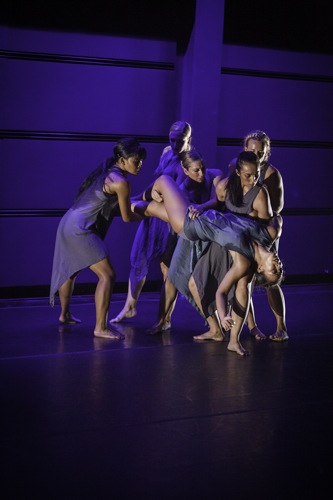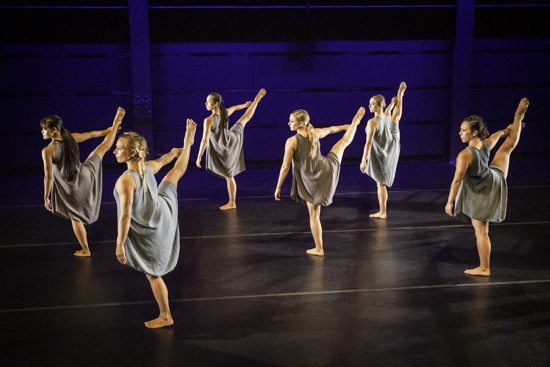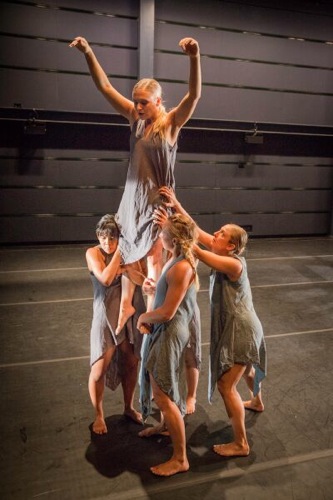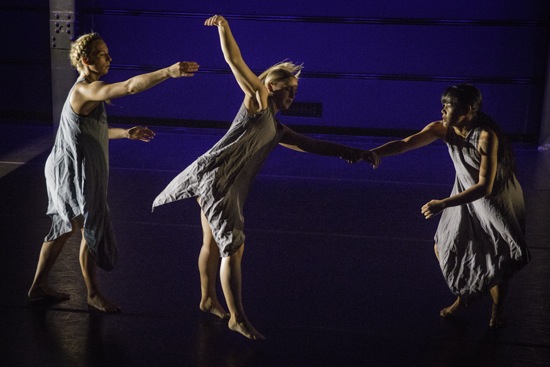Summation Dance celebrates its fifth anniversary at BAM Fisher.

Members of Summation Dance (L to to R: Devin Oshiro, Megan Wubbenhorst, Allie Lochary, Angela Curotto, and Taryn Vander Hoop) hold Sumi Clements in Clements’ At the Hour. Photo: Larson Harley
Perhaps someone some day will write an essay about dance titles, how they vary —encapsulating a theme, for instance, or borrowing from literature, or throwing spectators off the track with a word or phrase that has a secret meaning for the choreographer. Summation Dance titled its latest work At the Hour. What strikes you first? Those raised in Catholicism may think of the “Hail Mary: “. . .pray for us sinners now and at the hour of our death.” Other dance goers may follow up the ambiguous phrase with their own ideas about this important hour, while still others shrug off the title altogether.
Advance press material noted that choreographer Sumi Clements’ inspiration came from 1960s Spain, when four young girls in the village of Garabandal famously claimed to have received visitations from the Virgin Mary or her deputy, St. Michael, prophesying catastrophes to befall sinners from on high.
At the Hour, which premiered at BAM’s Fishman Space in the week following Labor Day, is Summation Dance’s first long (slightly under an hour) work. It celebrates the fifth anniversary of this six-woman company that appeared the same spring that its founders, Clements and Taryn Vander Hoop, graduated from New York University’s Tisch School of the Arts with MFAs (I knew them back then).
Clements is Summation Dance’s principal choreographer and co-artistic director, Vander Hoop is its executive director and co-artistic director. Talented and resolute, the two have attracted donors and forged ahead, averaging four appearances a year for the group. Welcome to the world of modern dance and postmodern dance—a world in which almost every dancer has another job.

(L to R): Devin Oshiro, Taryn Vander Hoop, Angela Curotto, Megan Wubbenhorst, Allie Lochary, and Sumi Clements in At the Hour. Photo: Larson Harley
I mention this background because Summation’s dancers are not onstage wimps or idealized creatures or conceptual artists; they are tough, determined, earthy women. They do not soar into the air; they plant their feet apart and hunker down. They are not into wasting time.
In At the Hour, they have no truck with glamor either. Brigitte Vosse has costumed them all in loose, sleeveless dresses that conceal the shape of their bodies, but don’t hide the sweat stains that darken the fabric’s muted colors. Clearly, the world these women inhabit is a dangerous one, and they inhabit it together—a tribe that holds its rites together, promotes fellowship, and is disturbed by occasional conflicts and an atmosphere in peril.
The beginning of At the Hour is especially striking for its use of the flexible Fishman Space. Megan Wubbenhorst is alone onstage, facing an audience banked on one side of the room. Nothing hides the armature of the building’s interior; we might be inside a giant submarine. Kyle Olson’s commissioned score starts of with quiet, intermittent rattling sounds and tickings. Wubbenhorst is doing something both mysterious and compelling. She seems askew in some way—careful, contained, but not sure where gravity is pulling her. Glued to one spot, she leans, gazes into the space, balances in tiptoe, revolves—always slowly, experimentally. Then she looks up.
So do we. There is a dancer on either of the empty two side balconies, standing still and watching or beginning to move slowly. During this passage, they may disappear and reappear on the opposite side, and what moves they make increase in scale and distance travelled along the narrow paths. From my vantage point, Devin Oshiro is especially vivid—rushing along, spinning into deep, wide-legged squats. Then Simon Cleveland’s lighting subtly but firmly draws our attention even higher. Omigod! Clements and Vander Hoop are clambering around on the heavy metal grating that lies beneath the overhead lighting equipment. I’d say they’re monkey-like, but they’re too cautious for that. This is unfamiliar territory to them, and they don’t appear to be succeeding in finding a way out (if that’s their aim). Down below, Wubbenhorst continues her own explorations, and gradually she is joined by the others: Angela Curotto, Allie Lochary, Oshiro, and, soon, the two overhead explorers.
What I identified as ritual is simply big, fierce, often fluid dancing that the members of this society know, or learn by watching. It may involve odd and striking coordinations, but, arduous though it is, it shuns conventional virtuosity.. Clements is adept at introducing a theme through, say, one performer and then letting it infect others or crop up later in other circumstances. The six dancers may fall into unison or three-part counterpoint; two may dance together at the same time as two others—confrontationally or helpfully—both the pairs independently occupying the same area at the same time.
Enigmatic dramas crop up briefly. Two bars of light slide along the floor to mimic the vertical supports on the back wall. Bells ring in Olson’s score, and a short rhythmic motif begins to repeat. Oshiro and Vander Hoop join to manipulate Wubbenhorst, who—her eyes closed—moves with the slipperiness of a fish. Carefully turning her, pushing her, catching her, the two are intent on their job, whatever it is. But when they return her to her place and put her down on the floor, and Cleveland produces a tiny pool of light for her, she somehow hardens. Curotto tries every grip or leverage she can manage to lift Wubbenhorst or move her elsewhere, but can’t budge her. In the end, they both fall, a new musical texture arises, and the lights brighten.
This is not the only time that the action suggests a lesson being learned, a test being made. Wubbenhorst is clearly important in some way. Twice the others lift her high in a standing position, like a statue, or a visionary who needs to see into the distance.

Megan Wubbenhorst lifted by (visible L to R): Devin Oshiro, Taryn Vander Hoop, and Allie Lochary. Photo: Larson Harley
There is a point late in the piece when my attention flags. What has been urgent and fascinating begins to seem drawn out. I note how skillfully Clements is handling the formal devices of repetition and variation and varying the ways the dancers come together or separate, but I lose a sense of what these wary, watchful women want or are trying to accomplish. In the end, however, they find a destination. Olson’s music turns rhythmic, full, and insistent as, one by one, the six feed into a line that stretches across the space. Breaking away individually, rejoining again, they walk very slowly on tiptoe away from the audience toward the back wall, which turns russet. A sunset? A sunrise? An apocalypse? Will help come from above, or will disaster rain down on them? The hour—whatever it signifies—has come.


Thank you, Deborah. Once again you find language to illuminate the performance and bring the reader into a felt sense of the experience. I am particularly interested as Sumi Clements is a former student and I am thrilled that she and Taryn are persevering with this company.